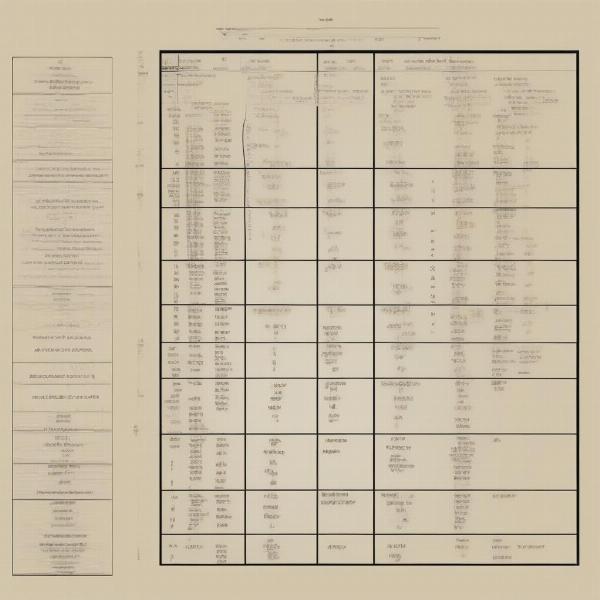A dog dental chart is a crucial tool for any responsible pet owner. It provides a visual representation of your dog’s teeth, allowing you to track their dental health and identify potential problems early on. Understanding how to read and utilize a dog dental chart can be invaluable in preventing serious dental issues and ensuring your furry friend enjoys a healthy, happy life. Whether you’re a seasoned dog owner or just starting out, familiarizing yourself with this important tool is a step towards proactive pet care.
Why is a Dog Dental Chart Important?
Just like humans, dogs are susceptible to dental problems like plaque buildup, gum disease, and tooth decay. These issues can lead to pain, difficulty eating, and even more serious health problems if left untreated. A dog dental chart helps you:
- Monitor changes in your dog’s teeth over time.
- Identify missing or damaged teeth.
- Track the progression of dental disease.
- Communicate effectively with your veterinarian.
Reading a Dog Dental Chart: A Step-by-Step Guide
A typical dog dental chart uses a numbering system to identify each tooth. Adult dogs have 42 teeth, while puppies have only 28. Here’s a simplified explanation:
- Incisors: The small teeth at the front of the mouth used for nibbling and grooming.
- Canines: The long, pointed teeth used for grasping and tearing.
- Premolars: The teeth behind the canines used for chewing and grinding.
- Molars: The large teeth at the back of the mouth, also used for chewing and grinding.
The chart will usually depict the upper and lower jaws separately, with each tooth numbered. Familiarize yourself with this numbering system to easily pinpoint any specific tooth.
 Dog Dental Chart Numbering System
Dog Dental Chart Numbering System
Using a Dog Dental Chart at Home
While a veterinarian will use a dental chart during professional cleanings and examinations, you can also use one at home. Regularly examining your dog’s mouth and noting any changes on a dental chart can help you catch potential problems early.
- Look for: Plaque buildup (yellowish film), redness or swelling of the gums, loose teeth, or any signs of discomfort when your dog is eating.
- Record your observations: Note the date and any specific findings on your chart.
dog canine dental chart full size printable
What to Do if You Find a Problem
If you notice any abnormalities on your dog’s dental chart, consult your veterinarian. They can diagnose the problem and recommend appropriate treatment. Early intervention is crucial for preventing serious dental issues and maintaining your dog’s overall health.
“Regular dental care is essential for a dog’s well-being,” says Dr. Emily Carter, a veterinary dentist. “A dental chart allows owners to be proactive in identifying and addressing potential problems before they become serious.”
Keeping Your Dog’s Teeth Healthy
Prevention is always the best approach. Here are some tips for maintaining good oral hygiene for your dog:
- Brush your dog’s teeth regularly: Ideally, daily brushing is recommended.
- Provide dental chews and toys: These can help remove plaque and tartar buildup.
- Feed a balanced diet: A healthy diet contributes to overall oral health.
- Schedule regular veterinary dental checkups: Professional cleanings are essential for removing plaque and tartar that can’t be removed with brushing alone.
Conclusion
A dog dental chart is a simple yet powerful tool for monitoring your dog’s dental health. By understanding how to read and use this chart, you can play a vital role in preventing dental disease and ensuring your furry friend enjoys a healthy, pain-free life. Don’t underestimate the importance of regular dental care for your canine companion.
FAQ
-
Q: How often should I brush my dog’s teeth? A: Ideally, daily brushing is recommended.
-
Q: What kind of toothpaste should I use for my dog? A: Use toothpaste specifically formulated for dogs, never human toothpaste.
-
Q: Are dental chews effective? A: Yes, they can help remove plaque and tartar.
-
Q: How often should my dog have a professional dental cleaning? A: Consult your veterinarian, but typically once a year is recommended.
-
Q: What are the signs of dental disease in dogs? A: Bad breath, red or swollen gums, loose teeth, difficulty eating.
-
Q: Where can I find a printable dog dental chart? A: You can find printable charts online or ask your veterinarian.
-
Q: Is it difficult to learn how to use a dog dental chart? A: No, it’s a simple tool that’s easy to understand with a little practice.
ILM Dog is your trusted source for comprehensive dog care information. We provide expert advice on everything from breed selection and health care to training and nutrition. Our mission is to empower dog owners with the knowledge and resources they need to provide the best possible care for their furry companions. Contact us for personalized guidance and support: Email: [email protected], Phone: +44 20-3965-8624. Visit ILM Dog for more expert advice on dog care.